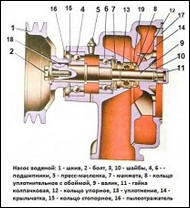- Fan, fluid coupling KAMAZ
- KAMAZ cooling system units
- Lubrication system KAMAZ
- Engine oil pump KAMAZ
- Oil filter KAMAZ
- Centrifuge KAMAZ
- Oil cooler Kamaz
- Diesel power system Kamaz
- Coarse filter Kamaz
- Fine filter Kamaz
- Low pressure fuel pump KAMAZ
- High pressure fuel pump KAMAZ
- Clutch advancing Kamaz
- Engine nozzle KAMAZ
- Frequency controller KAMAZ
- Fuel supply control drive KAMAZ
- Air supply of diesel Kamaz
- Exhaust gas system KAMAZ
- Turbocharger Kamaz
- Kamaz gas diesel power supply system






